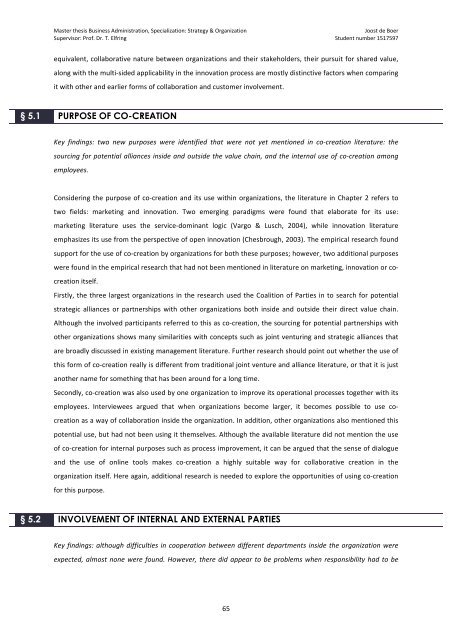Download PDF (English) - Future Ideas
Download PDF (English) - Future Ideas
Download PDF (English) - Future Ideas
Create successful ePaper yourself
Turn your PDF publications into a flip-book with our unique Google optimized e-Paper software.
Master thesis Business Administration, Specialization: Strategy & Organization <br />
Supervisor: Prof. Dr. T. Elfring <br />
Joost de Boer <br />
Student number 1517597 <br />
equivalent, collaborative nature between organizations and their stakeholders, their pursuit for shared value, <br />
along with the multi-‐sided applicability in the innovation process are mostly distinctive factors when comparing <br />
it with other and earlier forms of collaboration and customer involvement. <br />
§ 5.1 PURPOSE OF CO-CREATION<br />
Key findings: two new purposes were identified that were not yet mentioned in co-‐creation literature: the <br />
sourcing for potential alliances inside and outside the value chain, and the internal use of co-‐creation among <br />
employees. <br />
Considering the purpose of co-‐creation and its use within organizations, the literature in Chapter 2 refers to <br />
two fields: marketing and innovation. Two emerging paradigms were found that elaborate for its use: <br />
marketing literature uses the service-‐dominant logic (Vargo & Lusch, 2004), while innovation literature <br />
emphasizes its use from the perspective of open innovation (Chesbrough, 2003). The empirical research found <br />
support for the use of co-‐creation by organizations for both these purposes; however, two additional purposes <br />
were found in the empirical research that had not been mentioned in literature on marketing, innovation or co-creation<br />
itself. <br />
Firstly, the three largest organizations in the research used the Coalition of Parties in to search for potential <br />
strategic alliances or partnerships with other organizations both inside and outside their direct value chain. <br />
Although the involved participants referred to this as co-‐creation, the sourcing for potential partnerships with <br />
other organizations shows many similarities with concepts such as joint venturing and strategic alliances that <br />
are broadly discussed in existing management literature. Further research should point out whether the use of <br />
this form of co-‐creation really is different from traditional joint venture and alliance literature, or that it is just <br />
another name for something that has been around for a long time. <br />
Secondly, co-‐creation was also used by one organization to improve its operational processes together with its <br />
employees. Interviewees argued that when organizations become larger, it becomes possible to use co-creation<br />
as a way of collaboration inside the organization. In addition, other organizations also mentioned this <br />
potential use, but had not been using it themselves. Although the available literature did not mention the use <br />
of co-‐creation for internal purposes such as process improvement, it can be argued that the sense of dialogue <br />
and the use of online tools makes co-‐creation a highly suitable way for collaborative creation in the <br />
organization itself. Here again, additional research is needed to explore the opportunities of using co-‐creation <br />
for this purpose. <br />
§ 5.2 INVOLVEMENT OF INTERNAL AND EXTERNAL PARTIES<br />
Key findings: although difficulties in cooperation between different departments inside the organization were <br />
expected, almost none were found. However, there did appear to be problems when responsibility had to be <br />
65





